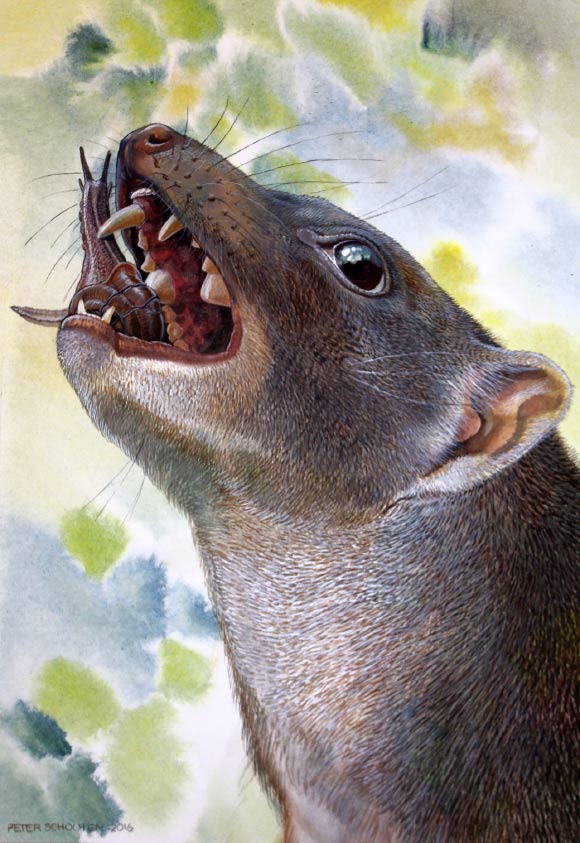Fossil remains of a previously unknown group of snail-eating marsupials that lived in Australia between 10 and 15 million years ago have been discovered by a team of paleontologists led by Prof. Mike Archer from the University of New South Wales.

Malleodectes mirabilis, a species in the family Malleodectidae, using its massive, ball-peen-like premolar tooth to break into what were perhaps one of this unique marsupial’s favorite meals – Riversleigh escargots. Image credit: Peter Schouten.
The new family has been named Malleodectidae (malleodectids), from the word for ‘hammer’ in Latin and ‘biter’ in Ancient Greek, referring to the presence of an enormous premolar that was clearly used for crushing hard food items.
Malleodectids were about the size of ferret and are known only from fossils from the Riversleigh World Heritage Area in far northern Australia.
Isolated teeth and partial dentitions of these strange marsupials had been unearthed over the years at Riversleigh, where Prof. Archer and his colleagues have excavated for several decades.
But the profoundly different nature of the malleodectid marsupials was not realized until a well-preserved portion of the skull of a juvenile was found in a 15 million year old cave deposit.
This specimen was only recently extracted from its limestone casing. The young malleodectid still had its baby teeth, and was teething, with adult teeth that had been about to erupt when it was alive still embedded in its jaw.
“Details of the canine, premolar and molar teeth of this specimen have enabled its relationships to other Australian marsupials to be determined with reasonable confidence,” Prof. Archer explained.
According to the team, malleodectids were probably related to living Australian carnivorous marsupials such as quolls, the Tasmanian devil and the marsupial anteater or numbat, as well as the recently extinct thylacine or Tasmanian tiger.
However, malleodectids represent a lineage of marsupials that has been distinct since at least 23 million years ago.
“Discovering an entirely new family of marsupials is really remarkable – the discovery of such a weird animal just goes to show that we have much, much more to find about the evolution of mammals,” said co-author Dr. Robin Beck, from the University of Salford.
Research describing Malleodectidae is published in the journal Scientific Reports.
_____
M. Archer et al. 2016. A new family of bizarre durophagous carnivorous marsupials from Miocene deposits in the Riversleigh World Heritage Area, northwestern Queensland. Scientific Reports 6, article number: 26911; doi: 10.1038/srep26911







